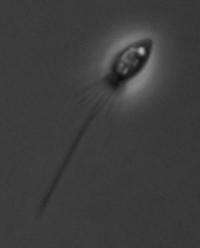Sodium channels evolved before animals' nervous systems, research shows

An essential component of animal nervous systems—sodium channels—evolved prior to the evolution of those systems, researchers from The University of Texas at Austin have discovered.
"The first nervous systems appeared in jellyfish-like animals six hundred million years ago or so," says Harold Zakon, professor of neurobiology, "and it was thought that sodium channels evolved around that time. We have now discovered that sodium channels were around well before nervous systems evolved."
Zakon and his coauthors, Professor David Hillis and graduate student Benjamin Liebeskind, published their findings this week in PNAS.
Nervous systems and their component neuron cells were a key innovation in the evolution of animals, allowing for communication across vast distances between cells in the body and leading to sensory perception, behavior and the evolution of complex animal brains.
Sodium channels are an integral part of a neuron's complex machinery. The channels are like floodgates lodged throughout a neuron's levee-like cellular membrane. When the channels open, sodium floods through the membrane into the neuron, and this generates nerve impulses.
Zakon, Hillis and Liebeskind discovered the genes for such sodium channels hiding within an organism that isn't even made of multiple cells, much less any neurons. The single-celled organism is a choanoflagellate, and it is distantly related to multi-cellular animals such as jellyfish and humans.
The researchers then constructed evolutionary trees, or phylogenies, showing the relationship of those genes in the single-celled choanoflagellate to multi-cellular animals, including jellyfish, sponges, flies and humans.
Because the sodium channel genes were found in choanoflagellates, the scientists propose that the genes originated not only before the advent of the nervous system, but even before the evolution of multicellularity itself.
"These genes were then co-opted by the nervous systems evolving in multi-cellular animals," says Hillis, the Alfred W. Roark Centennial Professor in Natural Sciences. "This study shows how complex traits, such as the nervous system, can evolve gradually, often from parts that evolved for other purposes."
"Evolutionarily novel organs do not spring up from nowhere," adds Zakon, "but from pre-existing genes that were likely doing something else previously."
Liebeskind, a graduate student in the university's ecology, evolution and behavior program, is directing his next research efforts toward understanding what the sodium channels do in choanoflagellates.
Provided by University of Texas at Austin



















